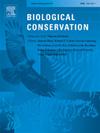Challenges for policy and practice in meeting ambitious ecological restoration targets by 2030: A perspective from Colombia
IF 4.9
1区 环境科学与生态学
Q1 BIODIVERSITY CONSERVATION
引用次数: 0
Abstract
Targets for ecosystem restoration have been made at global, regional, and national scales, but monitoring of progress remains challenging. Differences in definitions, goals, and practices among restoration initiatives, linked to policy drivers and funding sources, add complexity. We evaluate the current state of ecological restoration activity in Colombia, where, since 2012, legal requirements to compensate for environmental damage may be driving widespread restoration efforts, alongside a long history of government and private restoration initiatives. We systematically searched several public databases, and circulated an online survey, to collect records of 675 terrestrial and coastal restoration projects initiated between 1963 and 2021, capturing data on: location, funding, monitoring, ecosystem type and actors. Location was reported for 613 projects at municipality level, and 261 projects at point level. Restoration aims included recovery of ecological processes, hydrological processes, soil erosion, and natural resources. Only 24 % reported any monitoring, with just 2 % monitoring effectiveness. Forty-one percent of projects were enacted under environmental compensation laws. Funding was mostly from within Colombia, with minimal international funding. This work highlights major gaps in the monitoring needed to achieve effective implementation of restoration targets. Enhancing coordination among institutions, and enhancing monitoring, will now be crucial to achieving restoration goals.
求助全文
约1分钟内获得全文
求助全文
来源期刊

Biological Conservation
环境科学-环境科学
CiteScore
10.20
自引率
3.40%
发文量
295
审稿时长
61 days
期刊介绍:
Biological Conservation is an international leading journal in the discipline of conservation biology. The journal publishes articles spanning a diverse range of fields that contribute to the biological, sociological, and economic dimensions of conservation and natural resource management. The primary aim of Biological Conservation is the publication of high-quality papers that advance the science and practice of conservation, or which demonstrate the application of conservation principles for natural resource management and policy. Therefore it will be of interest to a broad international readership.
 求助内容:
求助内容: 应助结果提醒方式:
应助结果提醒方式:


